Click to Download the PDF
Download the Word Doc
President’s Message
Welcome to the March, 2022 edition of the Georgina Historical Society. We are planning to hold our first General Meeting of 2022 on Tuesday, April 19 at 7:pm. We are in the process of arranging a venue for the meeting with the town so we will send you an update on meeting details when this is determined. The meeting will be a “Bring and Brag” so please bring a photo or article from the past that you would like to share. Looking forward to seeing you on April 19!
There are some spring cleaning and sewing projects in need of volunteers at the Pioneer Village:
- Sort and clean wooden curtain rings and brackets.
- Sew curtains
- Polish silver for display
Please contact Melissa Matt, curator for more information.
There will be more volunteers needed for additional spring cleanup jobs as spring progresses. And of course we will need volunteers for Canada Day, Harvest Day, Sutton Fair and other upcoming events. Please let any board member know if you are able to assist with these events.
The Cedarbrae School will be reopening late spring. If you have any photos, articles, documents or stories relating to the Cedarbrae School that you could share please contact Melissa Matt, curator or the Georgina Historical Society.
Thank you.
Tom Glover, President
The Red Barn Theatre – By Paul Brady
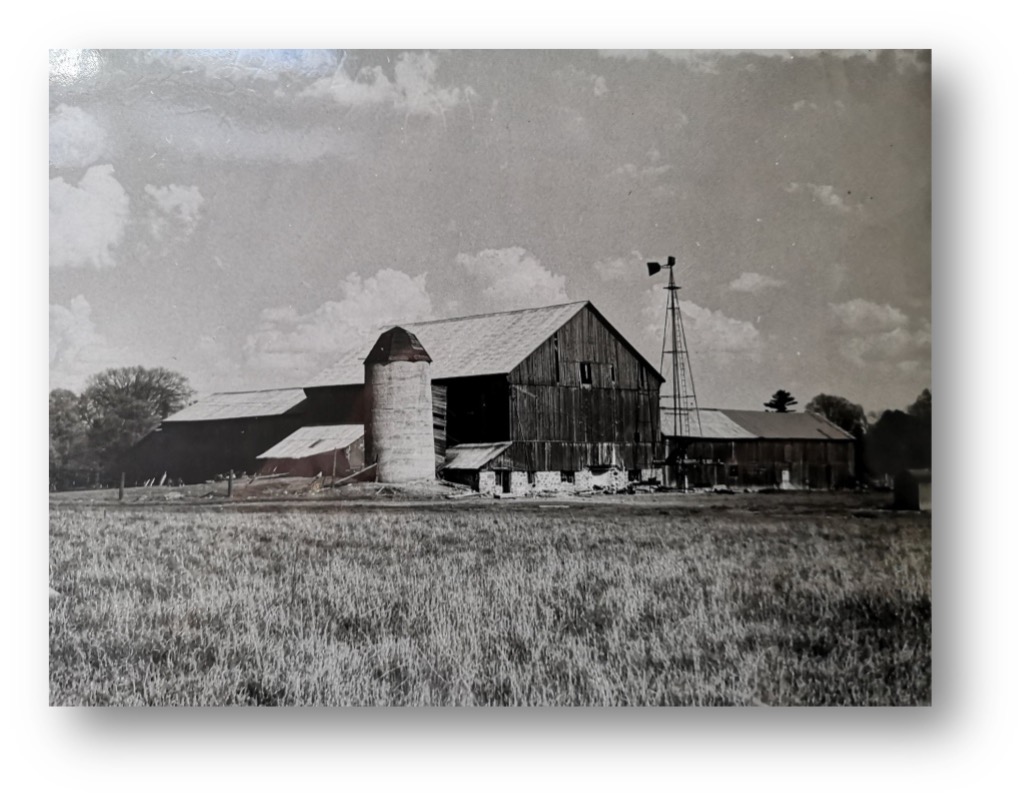
As we approach the anniversary of the devastating fire that destroyed the storied Red Barn Theatre in Jackson’s Point, it’s a great opportunity to take a look back at its history. At the time of the fire, April 18, 2009, the Red Barn was preparing to start its 61st year of use as a summer theatre. The original barn structure was built in the 1870’s by Dr. Frank Sibbald, owner of the Briars. By 1949 the structure, now owned by J.D. Sibbald, was little used as Mr. Sibbald had turned his attention to his golf course and summer resort business. However, it had captured the attention of Toronto actor Alfred Mulock, whose mother was a friend of Mr. Sibbald. It appeared to the young man that the under-utilized building lent itself to use as a summer theatre, and Mr. Sibbald agreed, so a dollar was paid to lease the barn for several years and the Red Barn Theatre was born.
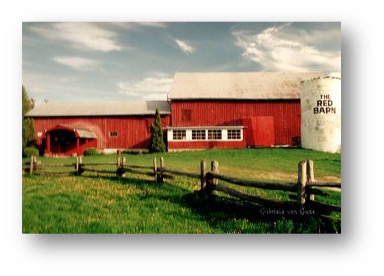
A fund-raising campaign was started and on July 1, 1949 a play entitled “The Little Foxes” was the premiere performance. Other plays that first season included “Glass Menagerie”, “Room Service” and “Night Must Fall”. That season brought rave reviews and much interest in the new theatre, but Mr. Mulock found that it was a little too much for him and he turned the keys back to Mr. Sibbald, who eventually settled all the debts from that first season.
A lawyer from Toronto, Brian Doherty, took on the theatre for the 1950 season. He produced five musical-comedies that season with sponsorship by the Sutton Kinsmen. Each successive season brought fresh new talent and producers to the Barn, and in 1956, Hal Jackman, who would go on to be Ontario’s 39th Lieutenant Governor, appeared on stage as the lead actor in the performance of “Rain”. That season also saw performances of “The Seven Year Itch” and “As I See it”. In 1958 a veteran of the Canadian theatre scene took over as the theatre’s resident director. Vernon Chapman, author, director, actor and later the president of the Canadian Actors Equity brought the plays “Tea and Sympathy” and “The Four-poster” to the stage. During this era numerous famous actors of the time appeared on stage, including Timothy Findlay and James B. Douglas.1968was a great year for the Barn. This season brought “The Fantasticks” and “Murder at the Red Barn”, both iconic plays that seem especially created for the summer theatre circuit.

Well attended and almost paying its own way, the Red Barn attracted patrons from around Ontario. But it wasn’t all fun and games. In the mid-fifties the barn and surrounding eight acres of land had come into the possession of Max Gold, a gentleman who owned several properties around the Point. Letting the barn operate as a theatre during his ownership, he sold it to a development company in 1969. Rumours of development on the land circulated, but in 1973 the company offered it to the Town in lieu of land that they had been asked to set aside for parkland. Local residents and business owners rallied, a consortium of people formed the Save the Red Barn Committee with John Sibbald as chairman, and the barn and surrounding acreage was put into the care of the newly formed Lake Simcoe Arts Foundation, a not-for-profit organization, and the theatre went on to operate for many more summer seasons.
Doug Beattie took over the barn in 1989, presenting the “Wingfield Farms” series of one-man shows. Mr. Beattie stated that “You get a sense that it’s a grand old, slightly decrepit dame that everyone wanted to maintain. Certainly, you heard about the kind people that had been there and at times it felt that the who’s who had all been there. ”Many people who went on to do great things in Canadian theatre cut their teeth in Jackson’s Point. Raymond Wickens, former general manager of Toronto Theatre and Andis Celms, who went on to run the National Art Centre are just two of them. Many famous actors and celebrities also appeared onstage or in fundraising drives. Valdy, Peter Mansbridge, Cynthia Dale, Loreena McKennit, Murray McLaughlin and numerous other people walked the streets of Jackson’s Point as they waited for their time in the limelight. The proud Canadian celebrity Peter Gzowski was a great supporter of the theatre. With his cottage just down the road, Peter’s fund raiser the “Peter Gzowski Invitational Golf Tournament” ran from 1986 until 2007, five years after his death. Known as Mister Canada, his gentle manner and likeable personality made it easy for him to attract talent to the barn in support of literacy.
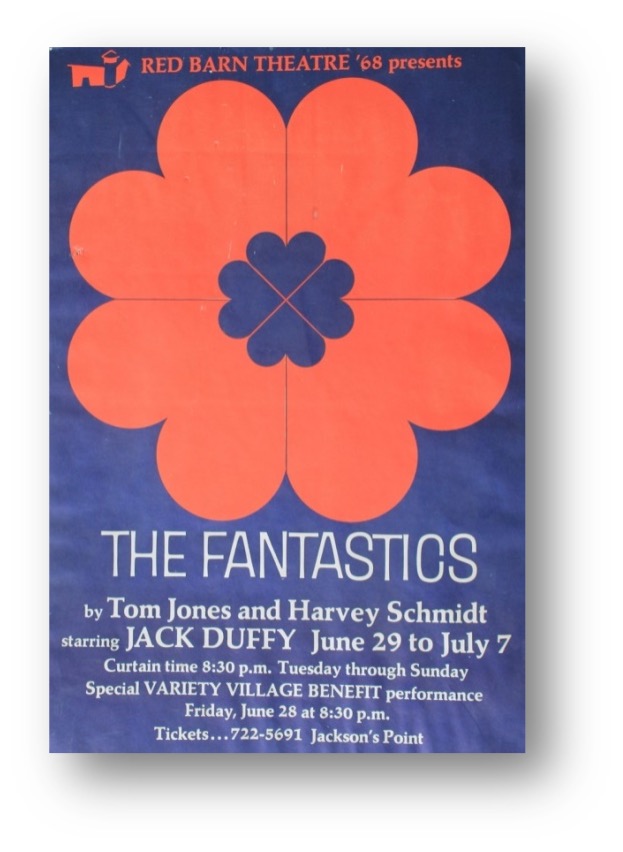
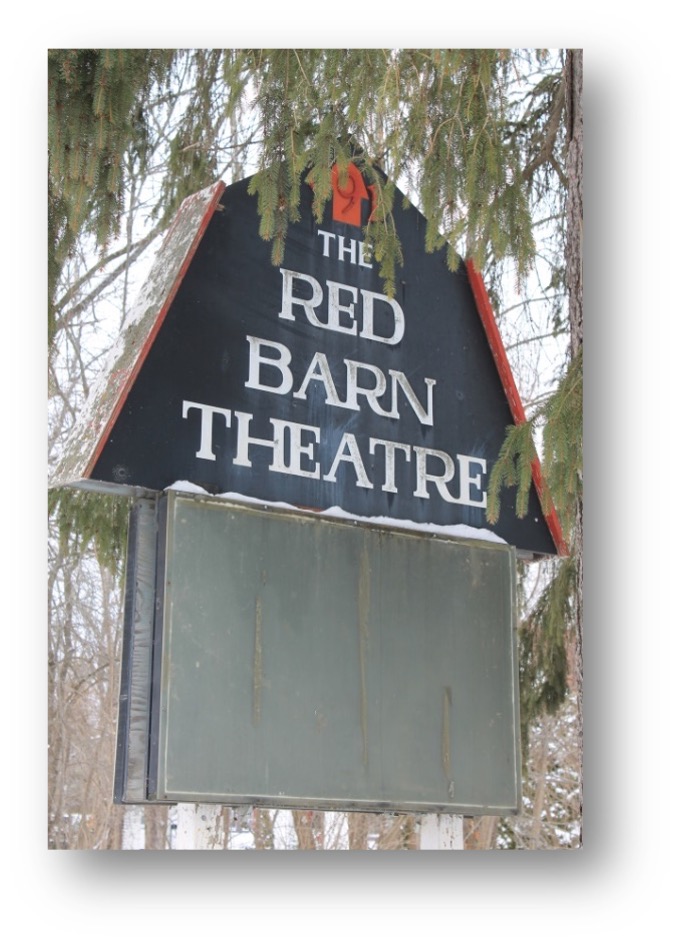
But the Red Barn wasn’t just famous people, wonderful evenings out and an intimate theatre experience; it was the bat who made an appearance at pretty well every show, usually at the perfect moment. We also must recognize the army of volunteers that made The Red Barn what it was. From ticket-taking, bar-tending, set decoration, costume making or cleaning up after the show, it was the volunteers who pulled it together. Drawing from an enthusiastic resource of local, and not so local, helpers, the amazing signs, wonderful snacks and coffee, and of course the legendary fifty-fifty draw all came together as professionally as any big city extravaganza.
The 2009 Red barn theatre season promised to be another great one. Artistic Director Jordan Merkur was preparing to present “The Glass Menagerie”, a play that had been presented 60 years previous in the premiere season, the perennial favourite “The Melville Boys”, and the classic “The Fantasticks”, a hit from 1969. Unfortunately, after dark on the evening of Saturday April 19, 2009 flames were seen erupting from the aged structure. Firefighters arrived quickly but all they could do was control the fire and by morning the physical Red Barn Theatre was gone. The Fire Marshall investigated, but no cause for the fire has ever been determined. Butin the immortal words of the theatre, the show must go on, and the 2009 season was conducted at the Stephen Leacock Theatre in Keswick. It wasn’t the same though, the crowds and the arts grants were smaller, and the Red Barn Theatre closed for good in April of 2010.There has been talk for years now of reviving the theatre, but funding is always the issue. Also, the Briars was sold several years ago now and the perfect location for a resurrected Red Barn, its original site, is no longer available, so another iconic symbol of warm summer evenings, professional theatre, and Jackson’s Point is gone.
The Lake Simcoe Junction Railway By R. W. Holden
In 1876, long after the Northern Railway had entered Newmarket, the Toronto & Nipissing Railway with local interests in Stouffville and Sutton built the 3’6” narrow gauge Lake Simcoe Junction Railway from Stouffville Junction to Jackson’s Point. With local politicians, the principals behind the line were George Laidlaw, William Gooderham Jr, and J. G. Worts. Narrow gauge lowered costs for equipment and construction. Engines and rolling stock were smaller and cheaper to build and the right of way required less ballast for the roadbed and lighter rail. Their goal was to tap into the steamer trade on L. Simcoe, agriculture, and timber resources on the east side of York County,
Eight stations with sidings were built beyond Stouffville Junction; Ballantrae, Vivian, Mount Albert, Zephyr Crossing, Ravenshoe (also known as Blake or Brown Hill), Baldwin, Sutton, and Jackson’s Point. A ninth station, Powell’s, was listed on several later timetables, was near Franklin south of Mount Albert and named for the owner of the property where that flag stop stood. Arriving in 1877, it entered Sutton west of Dalton Road. Sutton station was located above Baseline Road and a block west of Dalton roughly across from where Sutton District High School is situated. Extended to Jackson’s Point, the line crossed Dalton Road near Black River Road and followed north along present day Grew Blvd. past Lake Drive paralleling Lorne Street to the station and then took a bend eastward onto a local wharf. The original wharf could support up to four freight cars. Originally the single track on the wharf was doubled to accommodate the level of shipping loaded for travel south
Purchased by the Midland Railway in 1883 it was regauged to 4’8 ½” (known as standard gauge and the dominant gauge in North America and Europe) to facilitate interchange of rolling stock with other lines. Not only was heavier rail required to accommodate the larger equipment but also the roadbed had to be upgraded as well to support its extra weight. By 1893, the Midland was absorbed into the Grand Trunk Railway system and in 1923 it was merged into the Canadian National Railways.
In addition to the station, at Sutton there were two stock pens with single and double chutes and an agent’s dwelling. Sutton and Stouffville were the only stations with engine houses and turntables with a capacity of 45 tons and were 45’8” in length. Both stations and Mount Albert had water tanks to replenish engines; sidings and other tracks at Sutton and Jacksons Point could accommodate up to 50 cars. The only other station north of Stouffville with stock pens was Mt. Albert (4 pens with double chutes). The siding and spurs at Mount Albert could accommodate 68 cars.
Lake Simcoe Junction Railway Map

At this time, timber was a huge commodity, especially from East Gwillimbury and Whitchurch. Ballantrae and Vivian became the main centres for this trade. But significant log booms were shepherded by steamboats into Jackson’s Point and Belle Ewart harbours for shipment to hungry markets to the south. Additionally, a large demand from the railways for construction and fuel as well as in urban centres for heating and construction kept area saw mills busy right into the first decade of the twentieth century. Much timber was also exported to the United States as their eastern forests had become depleted.
The dark blue shows the route of the Lake Simcoe Junction Railway to Jackson’s Point. There were eight stations beyond Stouffville Junction.
Copied and cropped from C. S. Hammond & C. New York 1922 from “The New World Loose Leaf Atlas”,
Scale- 1:1,457,280
University of Alabama Online Map Collection
Large quantities of timber were rafted into Jackson’s Point for shipment south. Left is a view of the timbers in the harbor at Jackson’s Point during the latter part of the nineteenth century. The vessel in the picture is the Enterprise which regularly sailed to Barrie, Orillia and other ports on Lakes Simcoe and Couchiching.
Courtesy Georgina Public Archives
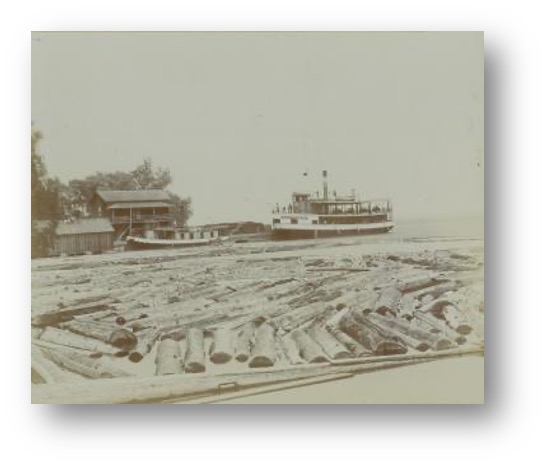
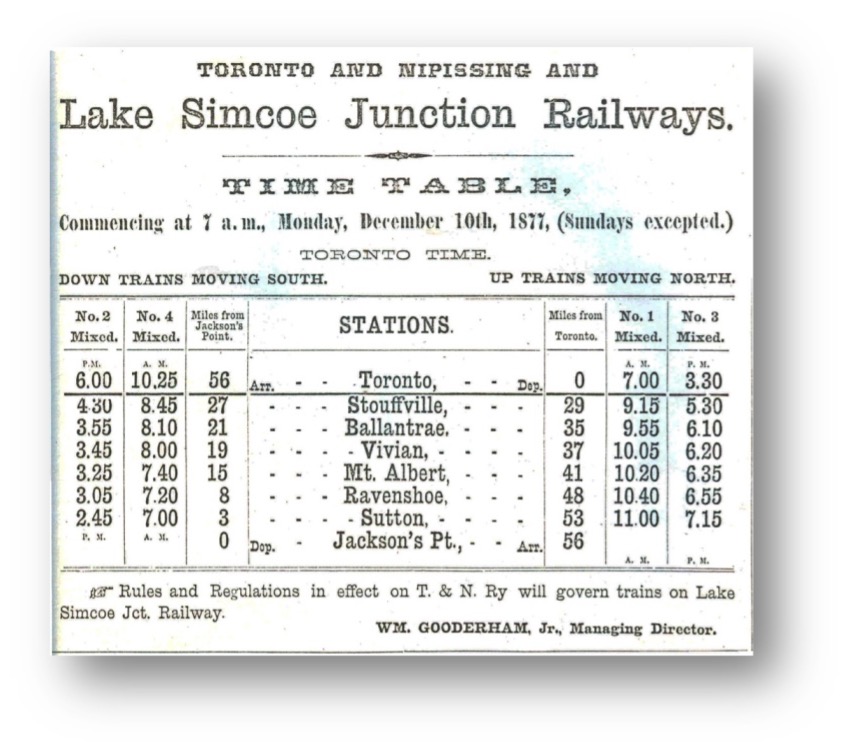
There were just two mixed trains (freight with a passenger coach attached) daily in each direction, later reduced to one. By the end of the first decade of the twentieth century, enough demand brought full passenger as well as a regular freight service. However , by May 19, 1928 all passenger service had ended.
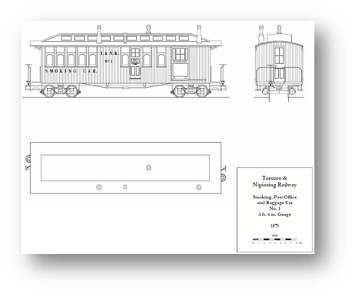
Left is a drawing of passenger equipment in use in the earliest years of the Lake Simcoe Junction Railway. Equipment like this would have been tacked onto the end of a train consisting primarily of freight cars (small boxcars and flatcars).
In 1877 Sutton station welcomed the first train to Sutton. The engine in the photograph has a 4-4-0 ‘American’ wheel arrangement – 4 pilot wheels (two on a side), 4 drivers and no trailing wheels. This was the most common wheel arrangement at this time on all of the railways of North America. The engine here is likely one of six engines imported from England by the T&NR in the early 1870s.
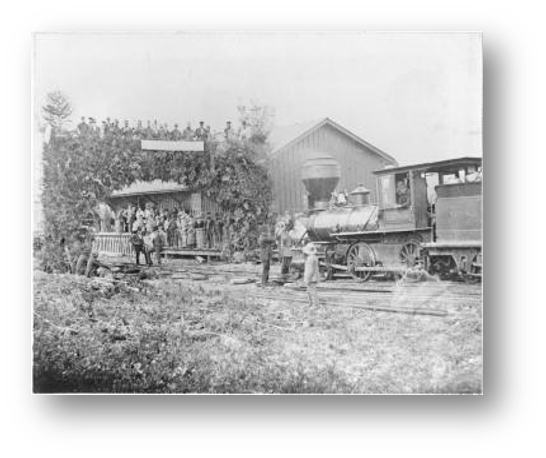
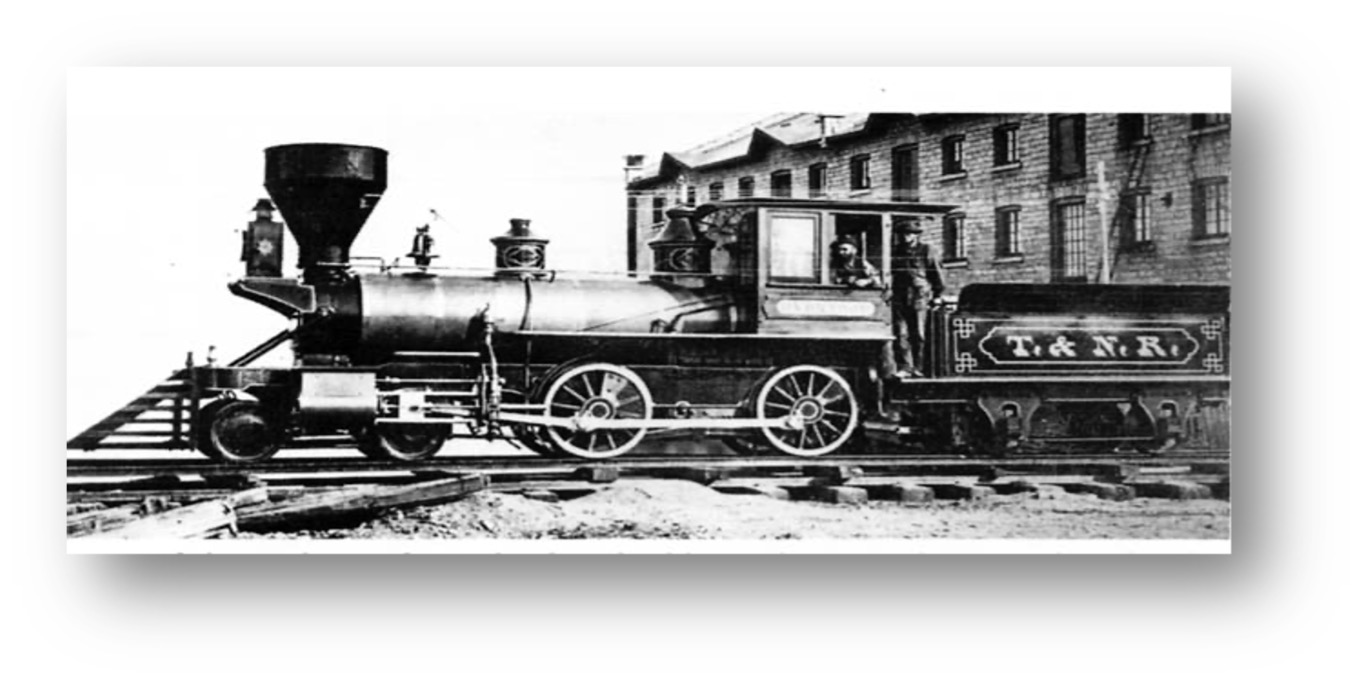
CLC/photographer unknown/ Bill Thomson/Kingston Pump House Museum collection.
Left is a narrow gauge (42″) engine Toronto & Nipissing no.6 Uxbridge that was one of an order of six 4-4-0’s delivered to the T&NR from England. This engine would have seen service on the Lake Simcoe Junction Railway. Note the four-wheel tender.
Below right and left – railway workers in 1898
Georgina Pioneer Village Archives
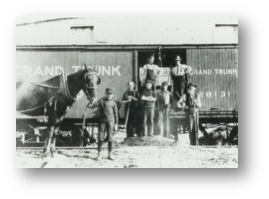
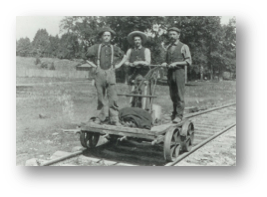
Below – Second Sutton Station 1900-1921
the first station was lost to a fire as was the second in 1921.
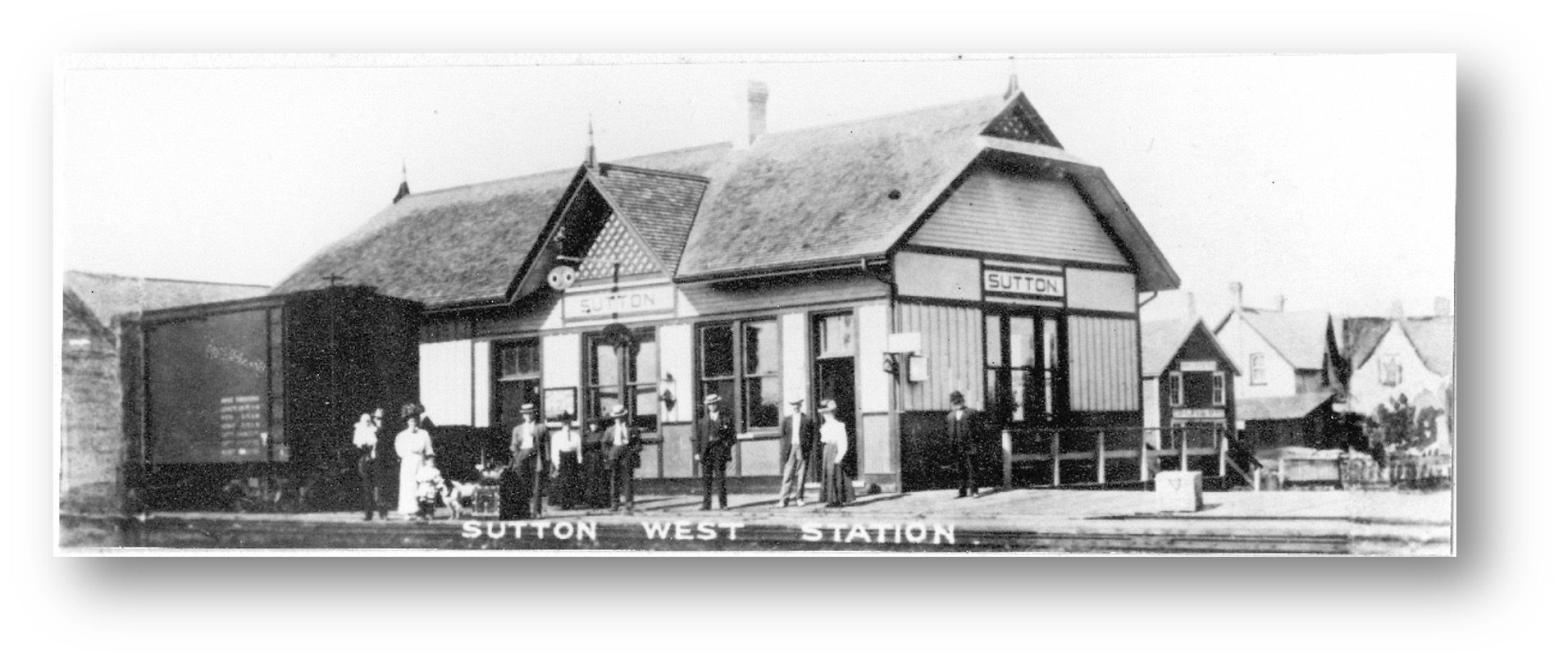
Third Sutton Station 1921 to abandonment now in Georgina Pioneer Village
Photo by R. W. Holden 2014
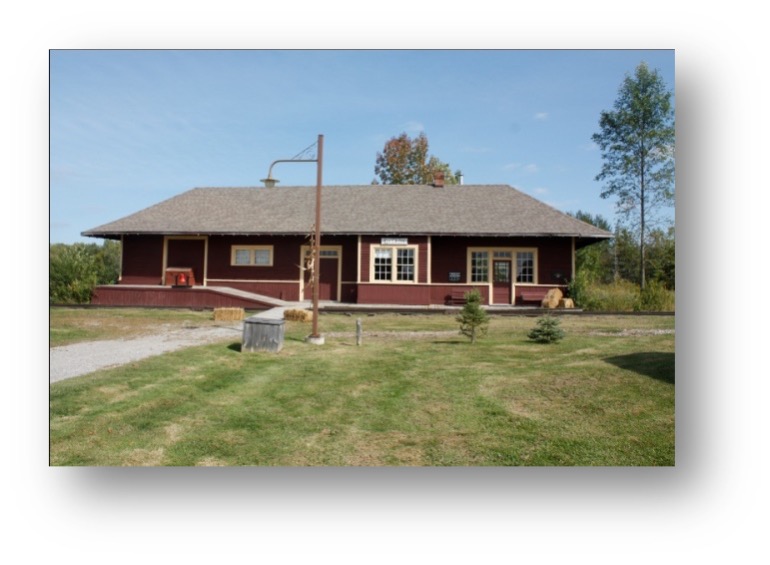
Economic Development
As a result of the railway, there was considerable economic development. Access to markets in the south were opened up for lumber, agricultural production and tourism.
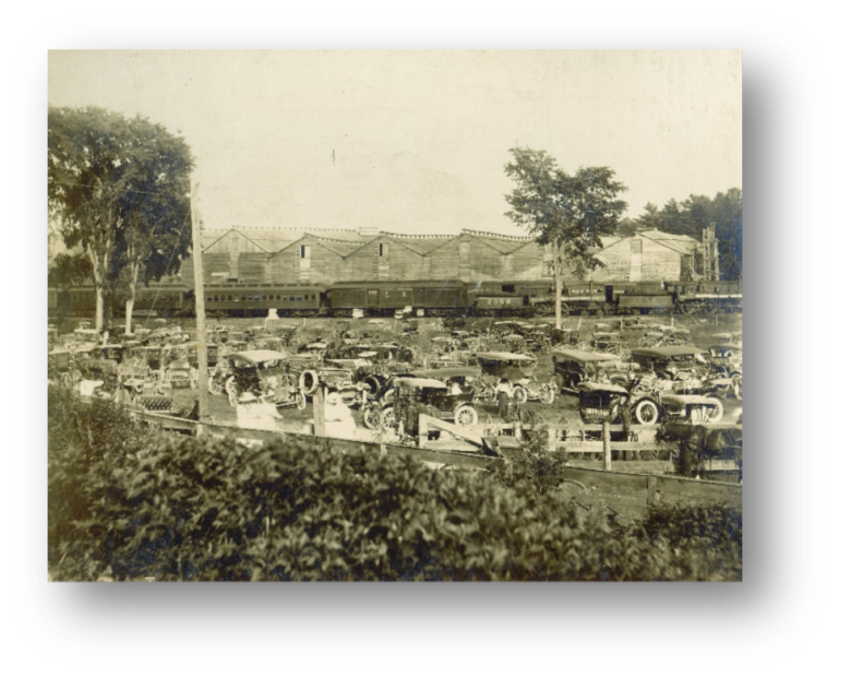
Left – Crowds in front of railway sidings and Lake Simcoe Ice storage houses ca. 1911. The ice company was the main supplier of ice to the cities in the south before refrigeration. Frequently as many as 10 to 15 carloads of ice would be shipped daily! Lower left is the Jackson Point Hotel, one of many guest Houses in the area.
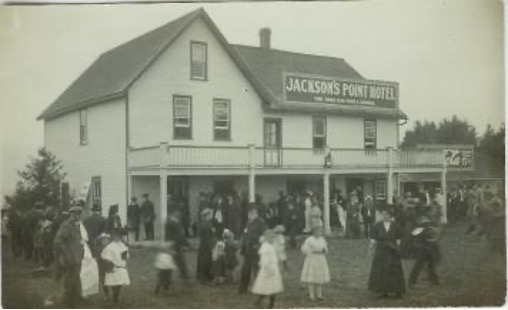
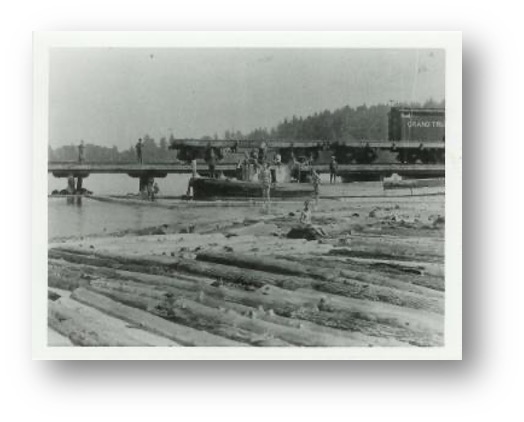
In 1928 the Lake Simcoe Junction line north of Sutton was abandoned and the Jackson’s Point station was closed. The link to the lake was no longer needed. By this time there were no more commercial steamboat services requiring a railway connection. On May 19, 1928 all mixed train service ended; the line would never carry passengers again. By December 25th of 1928 the tracks of the old Lake Simcoe Junction between Zephyr Crossing and Ballantrae were all taken up. Only the connection between Zephyr Crossing and
Sutton remained. By the 1970s most local freight services were eliminated: the spur from Stouffville to Ballantrae disappeared. In 1979, the Sutton line from Zephyr Crossing was permanently abandoned and the rails lifted.
Local economic development today depends primarily on the highway transportation infrastructure that gained ascendency during the twentieth century. Superhighways like the 400 series have had a profound impact on economic development similar to that of the railways in past generations.
Some Typical Equipment
Right -Consolidation type (2-8-0 wheel arrangement) used primarily in freight service
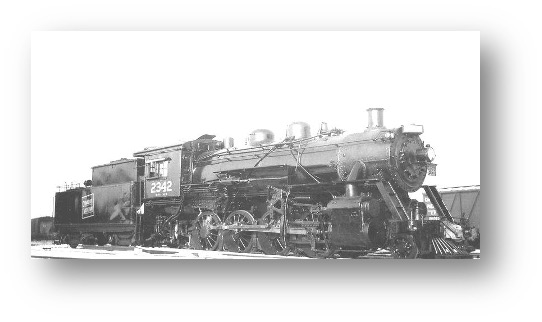
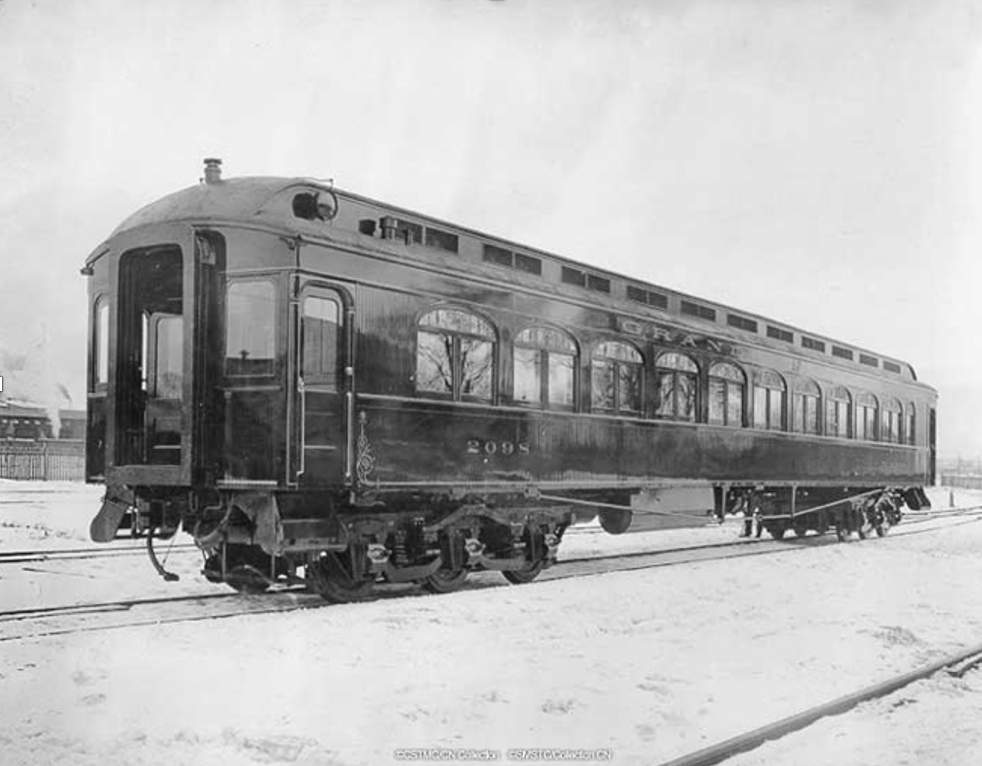
Left – A typical early 20th century wooden first class Grand Trunk Railway passenger car (no date)
Right – Early freight cars ca. 1905
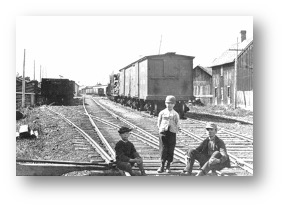
The Cedarbrae Schoolhouse

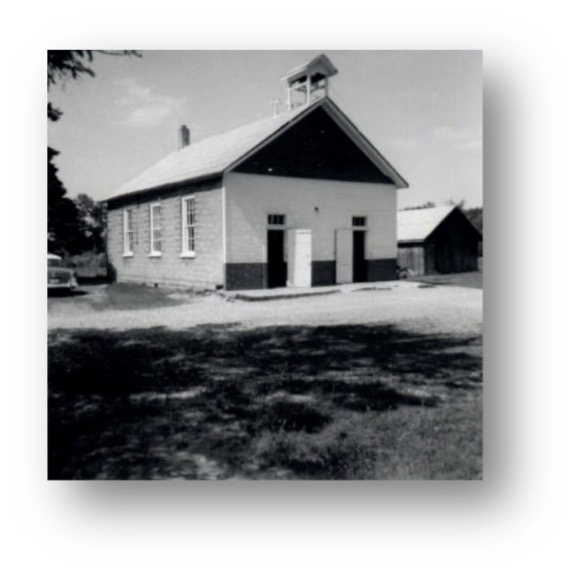
Here is our picture in the GHS calendar for the month of March and an old image from the late 1950s (inset); the last images of this building in our newsletter showed its demolition. We are happy to announce that the adaptive reconstruction is almost complete and that the new schoolhouse is expected to be open to the public once the Georgina Pioneer Village resumes operations again this June. What is wanted for the opening is images of its interior back in the day (if possible) and class pictures (there’s only six in the archives and they’re either poor quality or copies). Also a bit more historical information on the schoolhouse would be nice. If you can help us, please contact Melissa Matt at the Village (905-476-4301 ext 2284 or curator@georgina.ca), Tom Glover, or Bob Holden.
Food for thought…
A people without the knowledge of their past history, origin and culture is like a tree without roots.
MARCUS GARVEY
Where in Georgina?
Unsolved as yet…here again is our current mystery place; what and where is the location of the image to the right?
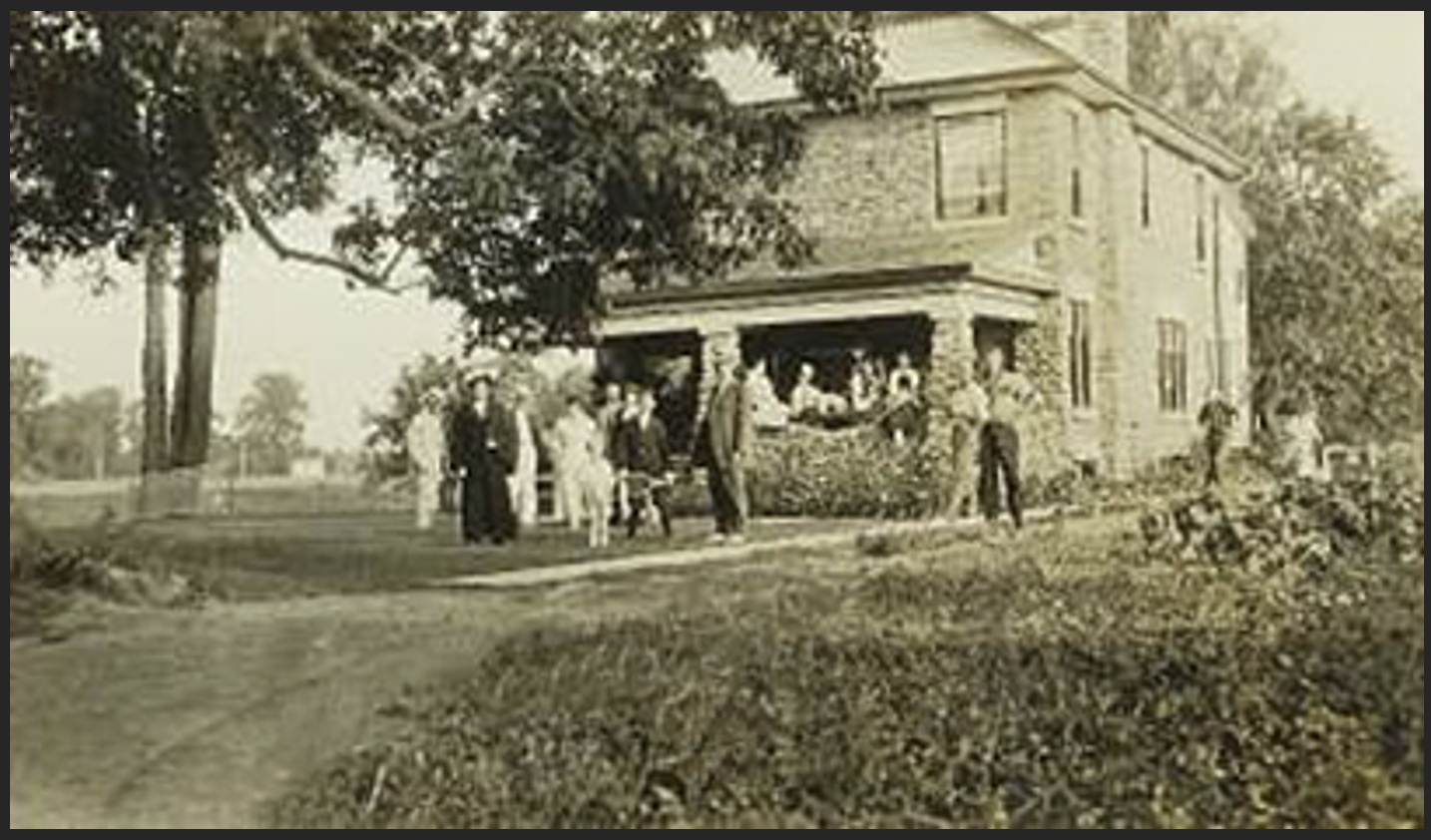
Our Pioneer Ancestors
EZRA SHERWOOD, lot 13, concession 5, was born in the Township of North Gwillimbury in the year 1817, being the son of Thomas and Annie (Mitchell) Sherwood. His maternal grandfather was the second settler in North Gwillimbury. When our subject was a boy they had to carry their grain to mill at Sutton, and he remembered when there was only one house in Sutton, besides the store. His grandfather assisted to make the first mill in that village, and came very near losing his life at the time.
Excerpted from the Georgina Township section of The History of the County of York, Volume 2, by C. Blackett Robinson Publisher in 1885, p. 510.
News
As of the 21st, most masking mandates and social distancing requirements are supposed to be gone. We can now meet together once again. Members will once again be advised of upcoming events and their dates, and as we get confirmations from the Town of Georgina, we will share the venues with you either by e-mail (if notice is short) or in subsequent issues of this newsletter.
Good News!! The adaptive reconstruction of the Cedarbrae Schoolhouse is almost completed. It is hoped that by the time for our May general meeting, we may use it for our venue so that the membership can have a preview peek at it.
With everything opening up, the GHS will need all hands on deck to help us with events and in getting the Village ready for its projected opening of June 4th. If you can help at the Village or would like more information, please contact Melissa Matt, the Curator of Georgina Pioneer Village at 905-476-4301 ext. 2284 or curator@georgina.ca. For all other events or queries please contact a GHS Board member for information.
As you know, we have raised concerns over the maintenance and well-being of our Pioneer Cemeteries. We feel that an inventory is needed of these places so they do not become lost to us. We also feel the Town should do more to maintain those closed cemeteries for which they are responsible. Finally, we’d like to appeal to the membership for any interesting anecdotes or stories of the past that might be shared with the membership. Over time much of these recollections get lost to us and should be written down and recorded for future generations so they might learn more about our past.
Events
Board Meeting April 4th 2PM, venue to be determined
General Meeting – May 17th 7 PM Coffee & Cookies 6:30 Bring and Brag; venue to be determined…
May 19th – May general meeting possibly at the rebuilt schoolhouse…more info to come!
June 4th – Tentative opening of Georgina Pioneer Village…volunteers wanted to get the village ready and to help out at the opening.
July 1st – Canada Day at the Pioneer Village…volunteers needed
August 5th, 6th, and 7th – Sutton Fair 1st weekend in August volunteers need for our booth.
September 17th – Harvest Day at Georgina Pioneer Village…help needed here too!
